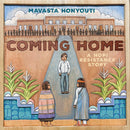Description
Mavasta Honyouti, Iswungwa (Coyote clan), is from Hotevilla, Arizona on the Hopi Reservation. The son of Ronald Honyouti and the grandson of Clyde Honyouti, he is an acclaimed Hopi katsina carver who has won Best of Classification three years running at the Sante Fe Indian Market and three Innovation Awards at the Heard Museum. In addition to his traditionally carved work, Mavasta carves scenes in low-relief as part of his plaque collection. His art features figures shown in Hopi environments wearing traditional attire, as well as references to movies, music, and popular culture.
From master Hopi woodcarver Mavasta Honyouti, the story of his grandfather’s experience at a residential boarding school and how he returned home to pass their traditions down to future generations.
When Mavasta Honyouti was a boy he would go with his grandfather to their cornfield, watching him nurture every plant. During breaks, his grandfather would take out a piece of paako root and use his pocketknife to whittle away. He made beautiful carvings that Mavasta would later learn to do himself.
But Mavasta would often wonder: what was his kwa’a like when he was a boy? And one day, he heard the story.
Mavasta’s grandfather, like many Native American children across the country in the late 19th and early 20th century, was forced to leave his Hopi reservation as a child and go to a residential boarding school far away. There, the government cut his hair, punished him for speaking his native language, and gave him a new name. But Mavasta's grandfather never forgot who he was – or where he came from – and he tried to escape again and again. Finally, he made it back to their reservation.
In later years, Mavasta’s kwa’a chose a simple life, taking great care of his family just like he took great care of his plants. His son and later his grandson became acclaimed Hopi katsina woodcarvers, just like him. Coming Home: A Hopi Resistance Story is a deeply personal book – written in both English and Hopi – that features sixteen stunning original painted wood carvings. It is an unforgettable testament to one man rising above a painful piece of history to keep the light of his family and culture alive. Audience: Ages 4-8.


